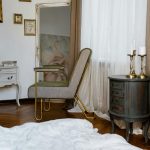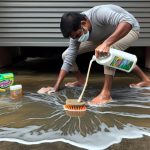To remove mold from fabric lawn chairs, first wear gloves and work outside in fresh air. Brush off loose mold gently, then spray undiluted white vinegar on affected areas. Let it sit for an hour, then scrub with a baking soda paste for stubborn spots. Rinse thoroughly and dry chairs in direct sunlight to kill spores. Proper drying and storage prevent mold return. If you want to protect your chairs longer, there are a few more tips to help.
Table of Contents
Key Takeaways
- Identify mold by looking for discolored spots, musty smells, or fuzzy textures on the fabric lawn chairs.
- Wear gloves, a mask, and work outdoors or in a well-ventilated area to protect from mold spores.
- Remove loose mold with a soft brush or vacuum, then spray affected areas with undiluted white vinegar and let sit.
- For stubborn mold, apply a baking soda paste or 3% hydrogen peroxide, let sit, then scrub gently and rinse.
- Dry chairs thoroughly in direct sunlight and ensure proper storage in dry, ventilated areas to prevent mold regrowth.
Identifying Mold on Fabric Lawn Chairs
How can you tell if your fabric lawn chairs have mold? First, look for discolored spots—these often appear as black, green, or white patches on the fabric.
Check fabric lawn chairs for mold by spotting black, green, or white discoloration on the surface.
You might also notice a musty, earthy smell, especially if the chairs have been stored in damp areas. Mold thrives in moist environments, so check areas that stay wet or shaded.
Touch the fabric; if it feels slimy or damp despite drying, mold could be present. Keep an eye out for fuzzy or powdery textures on the surface.
Don’t confuse dirt or mildew with mold; mold tends to spread and penetrate fabric fibers. Catching mold early helps prevent damage and makes cleaning easier.
Regularly inspecting your chairs after rain or humid days can save you trouble later.
Safety Precautions Before Cleaning
Before you start cleaning, make sure you wear protective gear like gloves and a mask to avoid exposure to mold spores.
You’ll also want to work in a well-ventilated area to keep fresh air flowing.
Taking these steps helps protect your health while you tackle the mold.
Wear Protective Gear
Wearing protective gear is essential when tackling mold on fabric lawn chairs to keep yourself safe from harmful spores.
Before you start cleaning, put on gloves to protect your hands from irritation and prevent spores from spreading. Use a mask or respirator rated for mold to avoid inhaling airborne spores, which can cause respiratory issues.
Don’t forget to wear safety goggles to shield your eyes from mold particles and cleaning solutions. Long sleeves and pants will help minimize skin exposure.
Choosing the right gear doesn’t just protect your health—it also prevents cross-contamination to other areas. Make sure your protective equipment fits well and is in good condition.
Taking these precautions allows you to clean confidently and reduces the risk of mold-related health problems.
Ensure Proper Ventilation
Once you’ve put on your protective gear, make certain you’re working in a well-ventilated area. Proper airflow helps reduce your exposure to mold spores and cleaning fumes, keeping you safer throughout the process.
Open windows and doors, and if possible, work outside to let fresh air circulate freely. If you must clean indoors, use fans to improve ventilation, directing them so air moves away from your breathing zone.
Avoid enclosed spaces where mold spores can easily accumulate. Good ventilation also speeds up drying after cleaning, which helps prevent mold from returning.
Taking these steps guarantees a safer, more effective mold removal process on your fabric lawn chairs. Don’t skip ventilation—it’s key to protecting your health while tackling mold.
Gathering Cleaning Supplies
Although tackling mold on fabric lawn chairs can seem intimidating, gathering the right cleaning supplies will make the process much smoother.
Start by grabbing a soft brush or sponge to gently scrub the fabric without causing damage. You’ll need a mild detergent or a specialized mold cleaner designed for fabrics. White vinegar or hydrogen peroxide can also be effective natural alternatives.
Don’t forget rubber gloves to protect your hands and a mask to avoid inhaling mold spores. Have a bucket of warm water handy for rinsing and diluting cleaning solutions.
Finally, keep some clean towels or microfiber cloths ready for blotting excess moisture. With these supplies in hand, you’re well-prepared to remove mold safely and effectively from your lawn chairs.
Preparing the Fabric for Treatment
After gathering your cleaning supplies, it’s important to prepare the fabric properly before applying any treatment.
Start by taking your fabric lawn chairs outside to a well-ventilated area with plenty of sunlight. This helps reduce mold spores and prevents them from spreading indoors.
Next, use a soft brush or vacuum with a brush attachment to gently remove loose mold and debris from the fabric surface. Avoid scrubbing aggressively, as this can damage the material.
Gently brush or vacuum mold off fabric; avoid harsh scrubbing to prevent damage.
Once the surface is clear, check for any stubborn mold spots or stains that may need special attention.
Finally, give the fabric a quick rinse with water to loosen any remaining particles, then let it dry partially before moving on to the treatment step. Proper preparation guarantees the cleaning solution will work effectively.
Using Vinegar to Remove Mold
Because vinegar has natural antifungal properties, it’s an effective and safe choice for removing mold from your fabric lawn chairs.
Start by filling a spray bottle with white distilled vinegar—don’t dilute it. Spray the affected areas thoroughly, making sure the fabric is damp but not soaked. Let the vinegar sit for at least an hour to break down the mold spores.
Afterward, use a soft brush or cloth to gently scrub the area, loosening any stubborn mold. Rinse the fabric with clean water and allow your chair to air dry completely in the sun, which helps kill remaining mold.
Vinegar’s acidity tackles mold without harsh chemicals, making it ideal for regular maintenance and safe for most fabrics.
Applying Baking Soda for Stubborn Mold
If vinegar doesn’t fully remove the mold, you can try a baking soda paste for those stubborn spots.
Mix baking soda with water until you get a thick paste, then apply it directly to the affected areas.
Let it sit for a while before scrubbing and rinsing to get your fabric chairs clean again.
Baking Soda Paste Preparation
To tackle stubborn mold on your fabric lawn chairs, start by making a simple baking soda paste. Combine two tablespoons of baking soda with just enough water to create a thick, spreadable consistency—usually about one to two tablespoons.
Mix thoroughly until you get a smooth paste without lumps. Avoid adding too much water, as a runny paste won’t stick well to the fabric. You can also add a few drops of white vinegar for extra mold-fighting power, but this is optional.
Once your paste is ready, you’re set to apply it directly to the affected areas. Preparing this paste correctly guarantees it clings to the fabric, allowing the baking soda to penetrate the mold and help break it down effectively.
Application and Cleaning Tips
A thorough application of the baking soda paste is key to removing stubborn mold from your fabric lawn chairs.
You’ll want to evenly spread the paste over the affected areas to guarantee it penetrates deep into the fibers. Here’s how to do it right:
- Use a soft brush or cloth to gently apply the paste, covering all mold spots.
- Let the paste sit for at least 30 minutes to break down the mold effectively.
- Rinse the chair with clean water, making sure to remove all residue.
- Allow the chair to dry completely in direct sunlight to prevent mold from returning.
Following these steps gives you a fresh, mold-free chair ready for your next outdoor gathering.
Cleaning With Hydrogen Peroxide
Hydrogen peroxide works as an effective mold remover because it breaks down mold spores without damaging fabric fibers.
To use it, pour 3% hydrogen peroxide into a spray bottle and spray the affected areas generously. Let it sit for about 10 minutes to penetrate and kill the mold.
Afterward, scrub gently with a soft brush or cloth to lift the mold residue. Avoid soaking the fabric excessively, as too much moisture can cause further issues.
Once you finish scrubbing, rinse the chair with clean water to remove any leftover peroxide. This method is great because hydrogen peroxide naturally deodorizes, leaving your lawn chairs smelling fresh.
Remember to wear gloves and test a small hidden spot first to guarantee no discoloration occurs.
Drying and Preventing Mold Regrowth
Properly drying your fabric lawn chairs is essential to stop mold from coming back. After cleaning, make sure to dry them thoroughly to eliminate any moisture that mold loves.
Here’s how you can do it effectively:
- Place your chairs in direct sunlight for several hours; sunlight kills mold spores naturally.
- Use a fan or a hairdryer on a cool setting to speed up the drying process.
- Avoid storing chairs in damp or shaded areas where moisture lingers.
- Consider applying a fabric protector spray to create a moisture barrier.
Maintaining Fabric Lawn Chairs Year-Round
Even if you’ve successfully removed mold and dried your fabric lawn chairs, keeping them in good condition year-round requires regular care.
Store your chairs in a dry, well-ventilated area when not in use to prevent moisture buildup. Use breathable covers instead of plastic ones to avoid trapping humidity.
Clean your chairs regularly with mild soap and water to remove dirt and prevent mold spores from settling. Check for any damage or wear and repair it promptly to extend their lifespan.
During humid or rainy seasons, air out your chairs frequently to keep fabric dry.
Frequently Asked Questions
Can Mold on Fabric Lawn Chairs Cause Allergic Reactions?
Yes, mold on fabric lawn chairs can trigger allergic reactions. If you’re sensitive, you might experience sneezing, itching, or breathing issues. It’s important you clean the mold promptly to protect your health and comfort.
Is It Safe to Use Bleach on Fabric Lawn Chairs?
Did you know bleach can cause fabric damage in over 30% of cases? You shouldn’t use bleach on fabric lawn chairs because it weakens fibers and fades colors. Instead, opt for gentler mold removal methods to protect your chairs.
How Long Does Mold Take to Grow on Fabric Chairs?
Mold can start growing on fabric chairs within 24 to 48 hours if the conditions are damp and warm. You’ll want to dry and clean your chairs quickly to prevent mold from spreading and causing damage.
Can Mold Damage the Chair’s Frame or Structure?
Yes, mold can damage your chair’s frame or structure, especially if it’s made of wood or metal. It weakens materials over time, causing rot or rust, so you should address mold growth promptly to protect your chair.
Are Commercial Mold Removers More Effective Than Home Remedies?
Think of commercial mold removers as sharp swords cutting through stubborn foes, while home remedies act like gentle breezes clearing light mist. You’ll find commercial options more effective for tough mold battles, but home solutions work well for mild cases.
- Choosing the Perfect Color Corduroy Pants for Your Wardrobe - July 3, 2025
- Style Guide: How to Style Beige Corduroy Pants Fashionably - July 3, 2025
- Stylish Outfits: What to Wear With Gray Corduroy Pants - July 3, 2025







